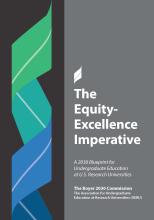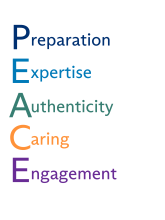College teaching is more than a job. It’s a calling, a vocation, and a mission, with distinct responsibilities. We aren’t meeting those responsibilities if we don’t design meaningful learning experiences; create engaging, immersive activities; and serve as a coach, role model, adviser and, when appropriate, confidant. Those of us who are privileged to hold such a position have a duty, a moral obligation, to provide the support and scaffolding that our students need. In the new year, let’s rededicate ourselves to the goal of bringing many more students to a bright future. (Mintz, 2023).
The start of each new term in higher education settings offers faculty opportunities for refreshing our professional goals, renewing our commitment to teaching and student learning, and reconnecting with our campus communities. Similar to University of Texas at Austin history professor Steven Mintz, many faculty members consider ways to effectively facilitate learning with undergraduate students. Authors of the recent Boyer Commission report (2022)—a group of higher education leaders led by Barbara Snyder, AAU President, and Peter McPherson, APLU President—suggested that research institutions, in particular, refocus on improving undergraduate education and closing what they labeled a diversity gap among undergraduate students (Snyder & Thorp, 2022).
The Boyer Commission established a guiding vision for their work, the Equity-Excellence Imperative: “a belief that excellence and equity and inextricably entwined, such that excellence without equity (privilege reproducing privilege) is not true excellence, and equity (mere access) without excellence is unfulfilled promise” (2022, p. 3).
One of the eleven provocations offered to realize this imperative focused specifically on the need for faculty to teach with evidence-informed pedagogies in inclusive learning environments. UCITE strives to empower people to learn, in part, by developing and maintaining resources for faculty to improve student learning across our campus. In this UCITE teaching and learning brief, our center highlights three strategies to help enhance effective teaching and learning drawn from the Science of Teaching and Learning literature: 1) checking for prior knowledge, 2) helping students organize knowledge for easier retrieval, and 3) frequent use of formative assessments. We also share examples of successful teaching practices from CWRU colleagues to provide additional context within our CWRU community.
Making a Memorable First Day and Week for Students
Students arrive to your first class ready to experience what you will do to help them learn, so... what can you do to keep that "first day" energy, interest, and engagement going throughout the term? Donald Saucier, a University Distinguished Teaching Scholar and Professor of Psychological Sciences at Kansas State University, curated ideas with a team of colleagues: Making Memories on the First Day of Class (2024). Saucier and his team suggest bringing PEACE to students:
Maya Angelou famously said, “I’ve learned that people will forget what you said, people will forget what you did, but people will never forget how you made them feel.” On the first day of class, we have the opportunity as instructors to bring PEACE to our students to help them feel supported and to develop rapport and trust that we are ready, able, and willing to help them learn this semester. “PEACE”, beyond being a wonderful word to describe the warmth and connection of a nurturing learning environment, is an acronym that specifies five foundations of excellent teaching: Preparation, Expertise, Authenticity, Caring, and Engagement (Saucier, 2019; Saucier, 2022; Saucier, Jones, Schiffer, & Renken, 2022).
Students—the people we guide and with whom we facilitate learning—typically want to engage with faculty—the people creating engaging teaching moments—to learn from and with one another. What we, as teachers, do in the first class and during the first week can make a difference in students' decisions to keep coming back and engaging. Even when the first day does not go exactly as planned, a little transparent conversation and perhaps a small change of direction can bring a class back to a space where memorable learning experiences will stick.
Check Students' Prior Knowledge to Align Where They Are with Where You Want Them to Go
Faculty can learn what students already know or what they can do by assessing students’ prior knowledge. UCITE founder and Biology Professor Emeritus Jim Zull advocated that “the single most important factor in learning is the existing network of neurons in the learner’s brain. Ascertain what they are and teach accordingly” (Zull, 2002, p. 93). When approached from a perspective of wanting to learn more about the students in our classes, measuring prior knowledge can assist in developing a positive and productive student-teacher relationship. For example, an instructor may inquire, “I’m going to ask you a few questions about quantitative research methods to get a sense of what you all already know. Then we’ll take some time as a group to explore pathways to move your knowledge forward towards our course objectives.” Sanmukh Kuppannagari, CWRU Computer and Data Science faculty member, employs a diagnostic assessment with his students. He describes two purposes for measuring students’ prior knowledge: 1) to help students gauge whether this is the best semester in their program to take the course, and 2) to help him design or revise learning activities in ways that will take into account students’ accurate and inaccurate prior knowledge. By aligning instruction with students’ prior knowledge, faculty can more effectively meet the needs of individuals, even if their prior knowledge was somehow adversely impacted during the first two years of the pandemic.
Teach Students How to Organize Knowledge for Easier Retrieval
Faculty create and maintain a complex network of knowledge and skills, and we organize that information around concrete and abstract structures that hold meaning for us. Our students, however, may not have similarly advanced organization skills to process and organize information. A faculty member in a UCITE educational development seminar once asked the question “Are we supposed to teach our students how to learn?” The answer to that question is emphatically “Yes!” If we want students to know and to be able to do something by the end of our course, we have to teach them how to accomplish those goals. This instruction takes time and effort, similar to teaching content or discipline-specific skills. Students lacking the means to organize their knowledge based on patterns they experience in the world will find it more difficult to retrieve and use that information (Bradshaw & Anderson, 1982; Reder & Anderson, 1980; Smith, Adams & Schorr, 1978). Jim Zull (2002) suggested several ways faculty can help students better organize knowledge and effectively build new associations through the formation of new networks of neurons:
- Teach students to transfer knowledge from one context to another by constructing metaphors and helping students to develop their own.
- Try to understand existing networks and build on them (e.g. meet students where they are, developmentally).
- Arrange for "firing together," that is, structure learning activities so that associated things occur at the same time.
Elizabeth Sell, CWRU Mathematics, Applied Mathematics, and Statistics faculty member, designs her Canvas modules as logically as possible, to help reinforce her sequenced class activities. She also provides students with skeletal outlines of her notes, so students have a foundation for their notes during interactive lectures. Sell notes that brief in-class or Canvas quizzes also help students retrieve important information as knowledge and skills continue to build throughout the course. Faculty might consider creating low-stakes or no-stakes quizzes in an effort to allow for students to practice their retrieval and recall skills. By repeating these types of shorter assessments, faculty can also help reinforce students’ ability to successfully organize existing and new knowledge.
Frequently Assess Content Retention, Skill Development, and Cognition Behaviors
Another way to help promote learning gains is through goal-directed practice by students, combined with targeted feedback by faculty. Feedback from faculty and self-reflection from learners can help students attain a desired level of performance (Ambrose et al., 2010). For example, distributing an assessment rubric at the same time an assignment is given can lead to a higher quality of student work and increased levels of what constitutes quality work in a given setting. Zull (2002) spoke about the need for recurring assessment as a way to connect “interactions between the physical constructs of neuronal networks inside the brain and the reality of the concrete world” (p. 209). In other words, it is not enough for a person to say they have learned, rather, they must be able to demonstrate that through actions (e.g. language).
Formative and summative assessments are two broad categories of learning measurement from the Science of Teaching and Learning literature (SoTL). Summative assessment refers to tools that measure learning results (e.g. final examination, capstone project, or thesis document). Formative assessment, a form of measurement that captures the process of learning, is an effective pedagogical tool to share targeted feedback with students (e.g. quiz, clinical observation feedback, or draft version of a research paper). Mercy College Teaching and Learning Center Director Juli Charkes (2022) cited SoTL resources suggesting that formative assessment enhances meta cognition and supports faculty satisfaction. She advocated for faculty to formulate questions in ways that invite self-reflection by students. When faculty learn how students are experiencing course activities, they can more effectively partner with students in co-creating learning. Charkes reported that more than 80% of faculty participants in an educational development initiative at her institution felt that access to student formative assessment data encouraged them to implement new teaching techniques.
CWRU Biology faculty member Rebecca Benard shares formative feedback with her students through conversations. These class engagements help her gauge students’ understanding while also informing her of their thought processes. Benard also provides time and space for students to reflect on their learning and how their thoughts about a certain concept or process change over time. She notes, “whenever possible, I have students loop back to connect new knowledge with prior knowledge.” Benard observes that this process of iteration-iteration-iteration facilitates retention and helps students make deeper connections among course concepts.
Effective undergraduate education creates greater access equity for a broad spectrum of students. Former CWRU President Barbara Snyder (2022) recently issued a challenge to higher education colleagues: “Every research university needs to commit, state publicly, and make good on the idea that undergraduate education and student welfare are top priorities.” As CWRU’s center for teaching and learning, UCITE is committed to supporting greater understanding of effective pedagogy to help ensure both excellence in education and “its inextricable link to equity” (Snyder & Thorpe, 2022). For more information about UCITE programs and grants, please visit us: case.edu/ucite.
UCITE faculty and staff colleagues are available to discuss these comprehensive teaching evaluation materials and the potential for implementation in a particular CWRU unit. Email us at ucite@case.edu.



